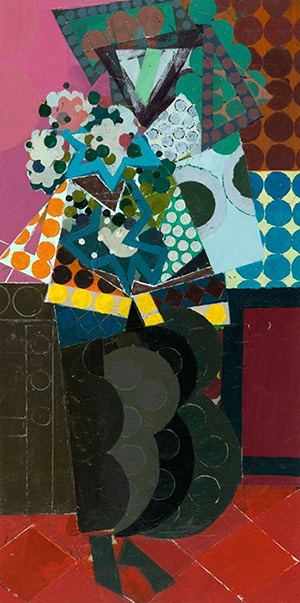Gross McCleaf Gallery: Ken Kewley: New Paintings February 3-26, 2016 back
Painter Ken Kewley definitely has a style, and for some visitors to Gross McCleaf, his tapestries of intensely colored geometric shapes might recall the decorative energy of the P & D movement of the 70s and early 80s. But unlike Joyce Kozloff, Robert Kushner, and other “Pattern and Decorationers,” Kewley adheres to the observed world, using the powers of painting to create empirically-based, if abstracted, scenes filled with light and depth. The coherence of these created worlds reveals an allegiance not to P & D but to the early modernists such as Braque, a painter the artist reveres. And to his great credit, Kewley captures not simply the superficial style of Braque, but a good deal of this master’s compositional vigor.
Immediately apparent in these 18 works is a penchant for turquoise-blues, acid greens, blue-grays and off-whites, punctuated by notes of intense reds. Also much in evidence is a sheer delight in pattern: arrays of stars, dots, and hexagons that hum as bouquets and pleats of fabric, or that chug through space as floor tiles or wallpaper. Choice details, like table edges and flower stems, emerge as conga lines of circles. One could take this elegant design-work as a cerebral riddle contrasting flat geometries and physical space. But what makes the paintings convincing is what they share with Braque: the plastic tension between forms, in shifting, contracting and expanding rhythms that not only denote objects but also animate them.
“Bouquet II,” for instance, recounts the story of a vase of flowers on a table, with colors weighting every movement, so that you palpably feel the blossoms billowing from the pillar of a vase, and holding in space just below our point of view. In this painting each event realizes its most basic character: a vase rests heavily on a table, the tabletop hovers above the floor, vase and table condense within the space of an interior.
The fragmented torso and abstracted head of “Figure IV” might well be taken for folded butterfly wings topped by a triangle. Either version would convince, as, visually, the torso/wings possesses all the pictorial weight of a complex, rising column. An eruption of dots become a bouquet of clutched flowers, while the culminating form of the head turns toward us, conveying, despite its blankness, a returned stare. In this exuberant re-creation of a scene, the inventorying of the known – the denotation of a robe’s folds rather than an insect’s wings – gives way to a primal visual experience, and a deeper kind of recognition.
Compared to merely decorative paintings, Kewley’s communicate in an elemental language based in the self-sufficiency of common objects. What does it mean to be a petal, amidst a hundred others, spreading above the plane of a table? In some existential sense, we’ll never quite know; our eyes imperfectly measure a world that finally defies measurement. But Kewley, speaking in a language peculiar to painting, offers compelling possibilities.
Gross McCleaf Gallery
127 S 16th St, Philadelphia, PA 19102
215-665-8138 · www.grossmccleaf.com
back
